What Is the Purpose of a Cover Letter?

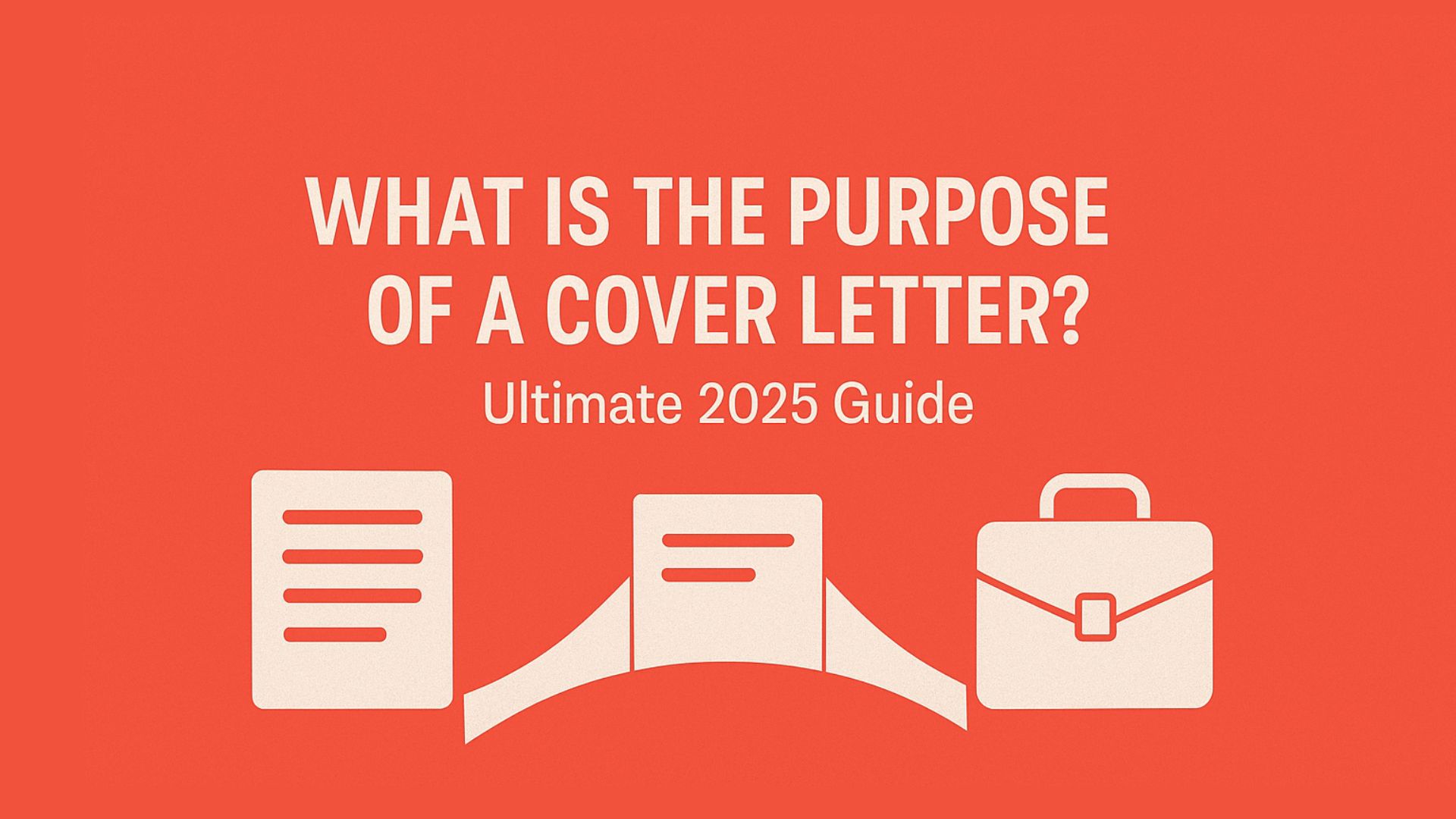
TL;DR
The purpose of a cover letter is to bridge your resume with the specific role you’re applying for, offering context that a CV alone cannot provide. A well-written cover letter demonstrates why you’re interested in the position, how your experience aligns with the company’s needs, and what makes you a strong cultural fit.
Rather than repeating your resume, it should serve as a strategic, persuasive pitch that highlights your motivation and key qualifications. In today’s hiring environment—where both AI tools and human recruiters review applications—a thoughtful cover letter can help you stand out, convey professionalism, and create a compelling first impression.
What Is the Purpose of a Cover Letter?
A cover letter (also known as a letter of application or job application letter) is a brief, personalized document that accompanies your resume. Its primary purpose is to explain why you’re interested in the role, highlight your most relevant skills, and demonstrate how you can add value to the organization.
It goes beyond listing qualifications — it connects your experience to the company’s needs and shows why you’re the right fit, making it a critical tool in modern hiring.
💬 “Your cover letter is your handshake in written form — personal, intentional, and persuasive.”
Why Cover Letters Still Matter in 2025
In today’s hiring landscape, job applications often go through Applicant Tracking Systems (ATS) and AI-driven screening tools before reaching a human recruiter. With remote and hybrid workplaces becoming the norm, first impressions are increasingly shaped by what’s written—not said. This is where a well-crafted cover letter makes a measurable difference.
According to recent hiring surveys, nearly 60% of hiring managers still read cover letters, especially for mid- to senior-level positions and roles that require strong communication skills. Many employers also note that a thoughtful letter can tip the balance between two equally qualified candidates.
Recruiters on Reddit Echo This Mixed Reality:
Some recruiters mention they only read cover letters when two resumes are similar, using them to assess gaps, intent, or cultural fit.
Others admit they don’t always read them unless required — but when they do, the effort often earns candidates “brownie points” or even an interview slot.
A few recruiters shared that exceptional cover letters have tipped the scale for candidates who might not have been obvious fits on paper.
Smaller companies and niche industries are more likely to value personalized letters, while some large corporations have even removed cover letter upload fields to streamline applications.
One recruiter summed it up perfectly:
“We hired someone this year whose background we typically wouldn’t consider, but her cover letter demonstrated exactly what we were missing. It made us look twice.”
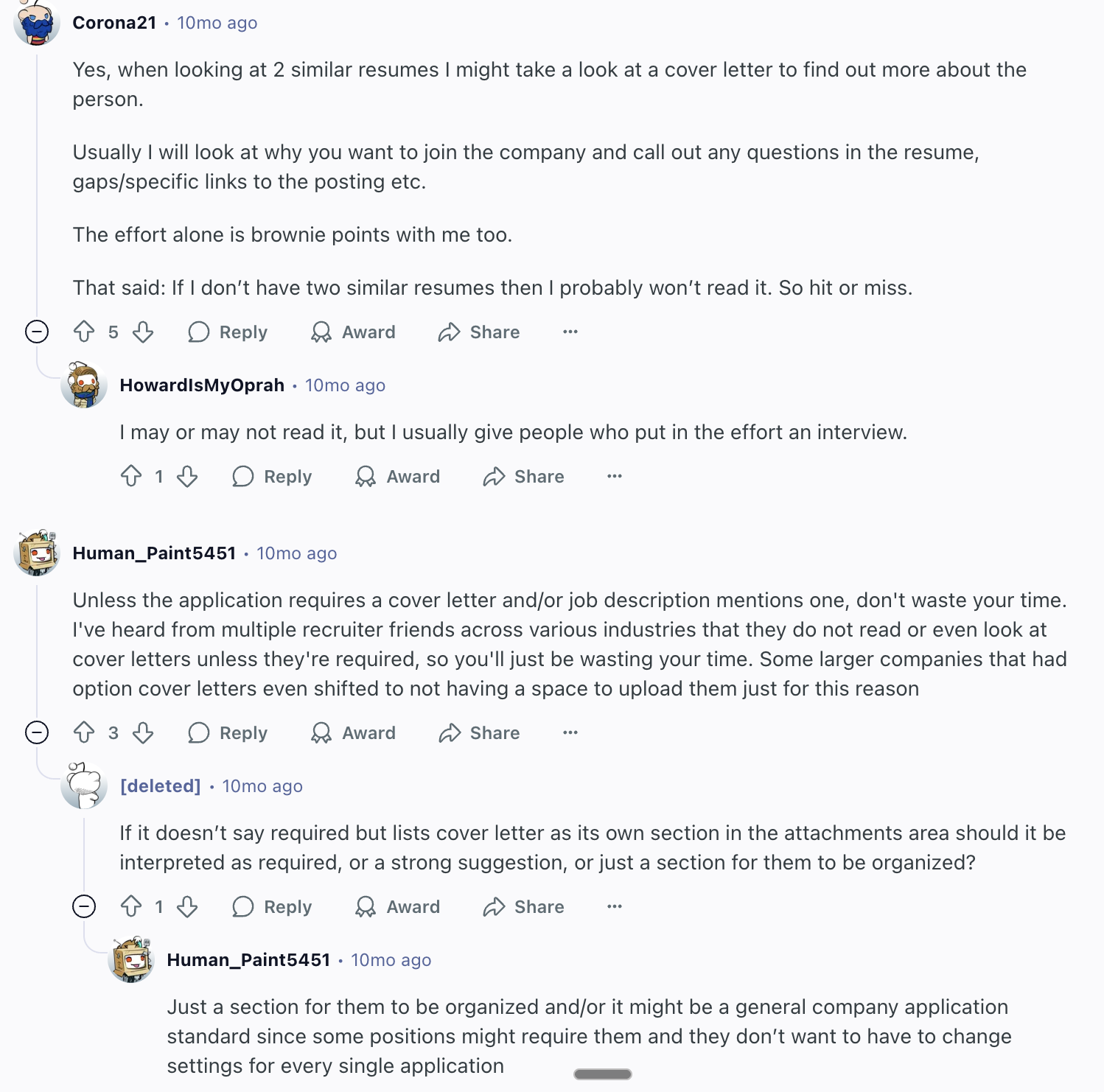
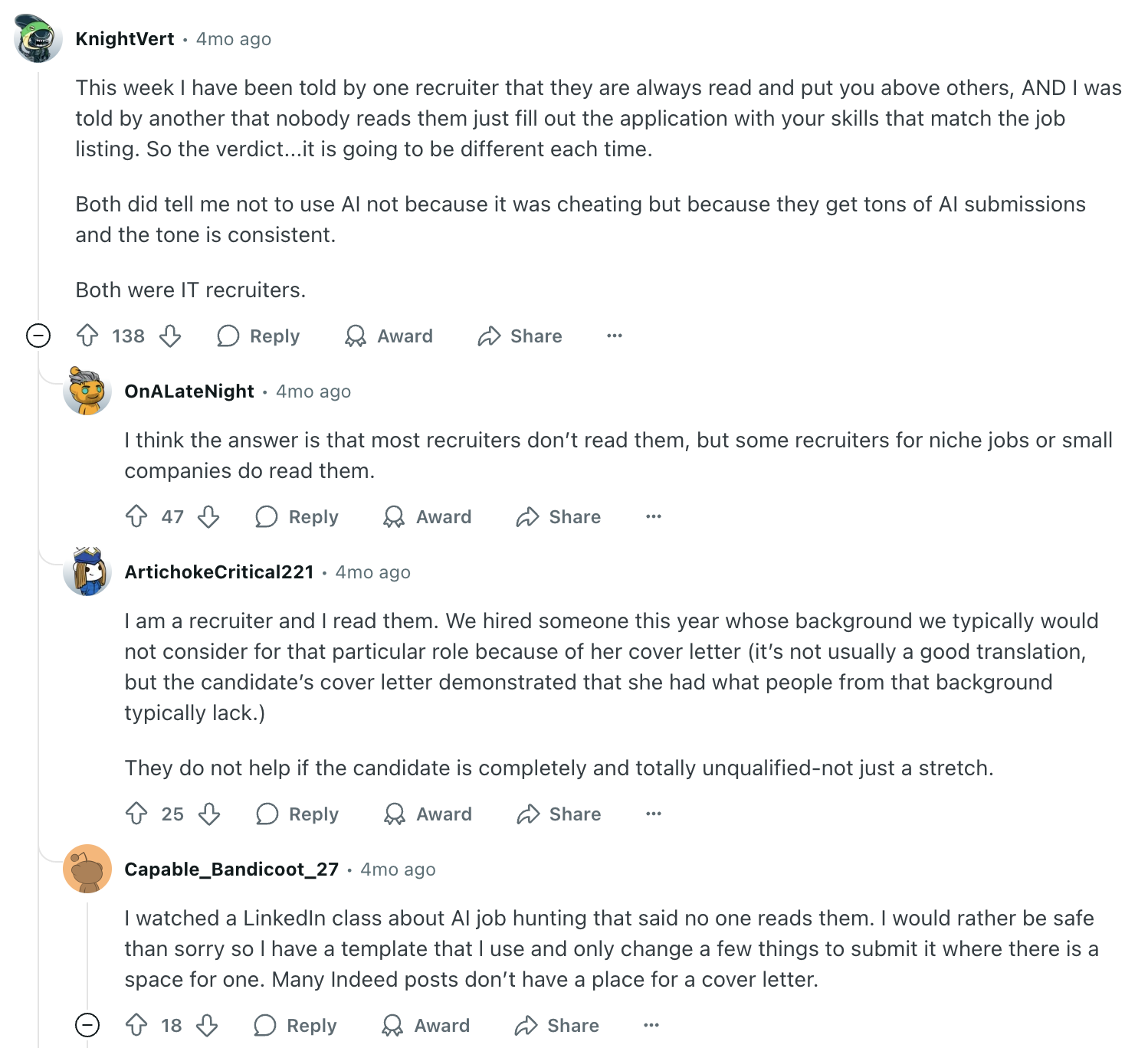
The Core Purpose of a Cover Letter (With Examples)
A strong cover letter goes beyond formality — it’s a strategic communication tool that connects your experience, motivation, and values to the specific role you’re applying for. Here are the four core purposes every effective letter should achieve:
1. Bridge Between Resume and Role
Your resume lists your skills and experience. Your cover letter explains why those skills matter to this role. It should clearly articulate why you’re interested in the position and how your background aligns with the company’s needs, creating a smooth bridge between what you’ve done and where you want to go.
Example of a strong “bridge” paragraph:
“When I saw the posting for the Marketing Strategist role at GreenLeaf, I was immediately drawn to your focus on sustainable branding. With five years of experience developing campaigns that increased customer engagement by 45% at EcoMarket, I’m excited by the opportunity to bring my expertise in growth strategy to a mission-driven team like yours.”
This paragraph establishes interest, connects experience to the company’s goals, and sets the tone for the rest of the letter.
2. Showcase Personality and Motivation
A cover letter is often the only part of your application written in your own voice. This is your chance to show genuine enthusiasm, add a personal touch, and explain your motivation for applying. Recruiters consistently say that letters with a unique voice feel more memorable and human compared to template-style submissions.
Use clear, authentic language — avoid jargon and clichés.
Share why the company’s mission, team, or work genuinely resonates with you.
Keep it professional, but let your natural tone shine through.
💡 Pro Tip: A letter that sounds human will always stand out in a stack of AI-generated templates.
3. Highlight Key Achievements Contextually
Rather than repeating your entire resume, choose one or two impactful achievements and explain them in a way that shows relevance to the role. Context is what turns bullet points into compelling narratives.
For example:
“In my previous role as a project coordinator, I led a cross-functional team that delivered a new client portal three weeks ahead of schedule, increasing customer retention by 20%. I’m eager to bring that same structured, outcome-driven approach to your operations team.”
This gives the hiring manager a clear, focused story that connects past success to future value.
“Think: one strong story beats five bullet points.”
4. Demonstrate Cultural Fit and Intent
Finally, your cover letter should signal that you’ve researched the company and see yourself thriving in its culture. This goes beyond technical skills — it’s about alignment with values, ways of working, and long-term vision.
Ways to show cultural fit:
Reference specific initiatives, values, or goals from the company’s website or recent news.
Use phrasing that mirrors their tone or mission statements (without copying).
Express genuine interest in contributing to their culture, not just filling a role.
Example:
“I’ve long admired BluePeak’s commitment to community-driven innovation. Your recent partnership with local nonprofits reflects values I share deeply, and I’m excited by the prospect of contributing to a team that blends technical excellence with social impact.”
In short: A great cover letter isn’t a summary — it’s a bridge, a story, and a signal of intent. It connects your experience to the role, lets your personality shine, highlights what truly matters, and shows you understand where you’re applying.
Related
What to Include in a Purpose-Driven Cover Letter
A strong cover letter follows a clear, structured format that allows both hiring managers and AI screening tools to quickly understand your value. Think of it as a concise, persuasive narrative with each section serving a distinct purpose.
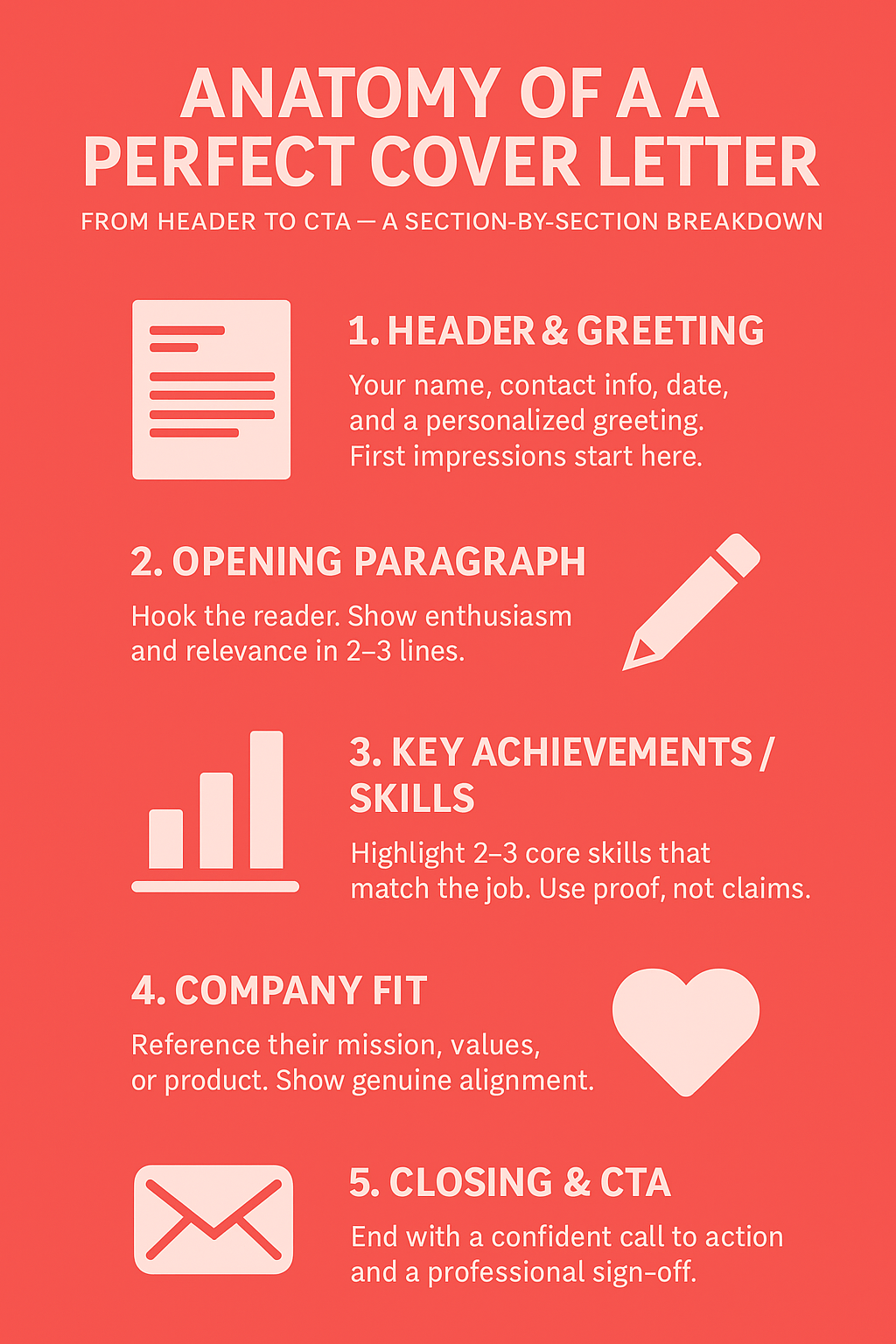
Here’s a simple checklist you can follow 👇
Essential Elements of a Good Cover Letter
Personal Greeting
Address the letter to a specific person whenever possible (e.g., “Dear Ms. Rodriguez”). If a name isn’t available, use a professional alternative like “Dear Hiring Manager,” rather than generic openings.Clear Reason for Applying
Open with a strong introduction that explains why you’re interested in the role and how it fits your career goals. This immediately establishes intent and relevance.Relevant Skills & Achievements
Highlight 1–2 accomplishments that align with the job requirements. Keep the focus on impact and context, not a full resume recap.Company-Specific Alignment
Demonstrate that you’ve researched the company — mention its mission, projects, or values — and show how your experience connects to what they’re doing. This is where personalization sets you apart.Confident Close & CTA
End your letter with a brief, confident closing that reinforces your interest and includes a call to action, such as expressing your eagerness to discuss the role further in an interview.
Why This Structure Works
It targets both human recruiters and automated systems
It ensures every line has a clear strategic purpose, avoiding generic filler
Common Mistakes That Undermine Your Purpose
Even the most qualified candidates can lose their edge if their cover letter misses the mark. Avoid these frequent pitfalls to ensure your letter strengthens — not weakens — your application.
Repeating Your Resume
A cover letter should add context, not restate your work history. Instead of listing job titles and dates, focus on why your experience is relevant to the specific role.
Using Generic Language
Phrases like “To Whom It May Concern” or copy-pasted templates feel impersonal and outdated. A personalized greeting and tailored content show genuine interest and effort.
Overly Formal or Robotic Tone
While professionalism is key, letters that sound stiff or AI-generated fail to make a human connection. Use clear, natural language that reflects confidence and authenticity.
Forgetting to Tailor
Sending the same letter to multiple companies is one of the fastest ways to lose a recruiter’s attention. Show that you’ve researched the company and understand its needs.
Weak Closing
Ending with vague phrases like “Hope to hear from you soon” can undercut an otherwise strong letter. Instead, close with a confident call to action, such as expressing interest in discussing your fit further.
Related:
💡 Pro Tip:
“If your letter could be sent to any company, it’s not doing its job.”
Real-World Examples (Good vs. Weak Purpose)
One of the clearest ways to understand the purpose of a cover letter is to see the difference between a strong opening and a weak, generic one. Your opening sets the tone — it tells the recruiter whether you’ve written with intent or copied a template.
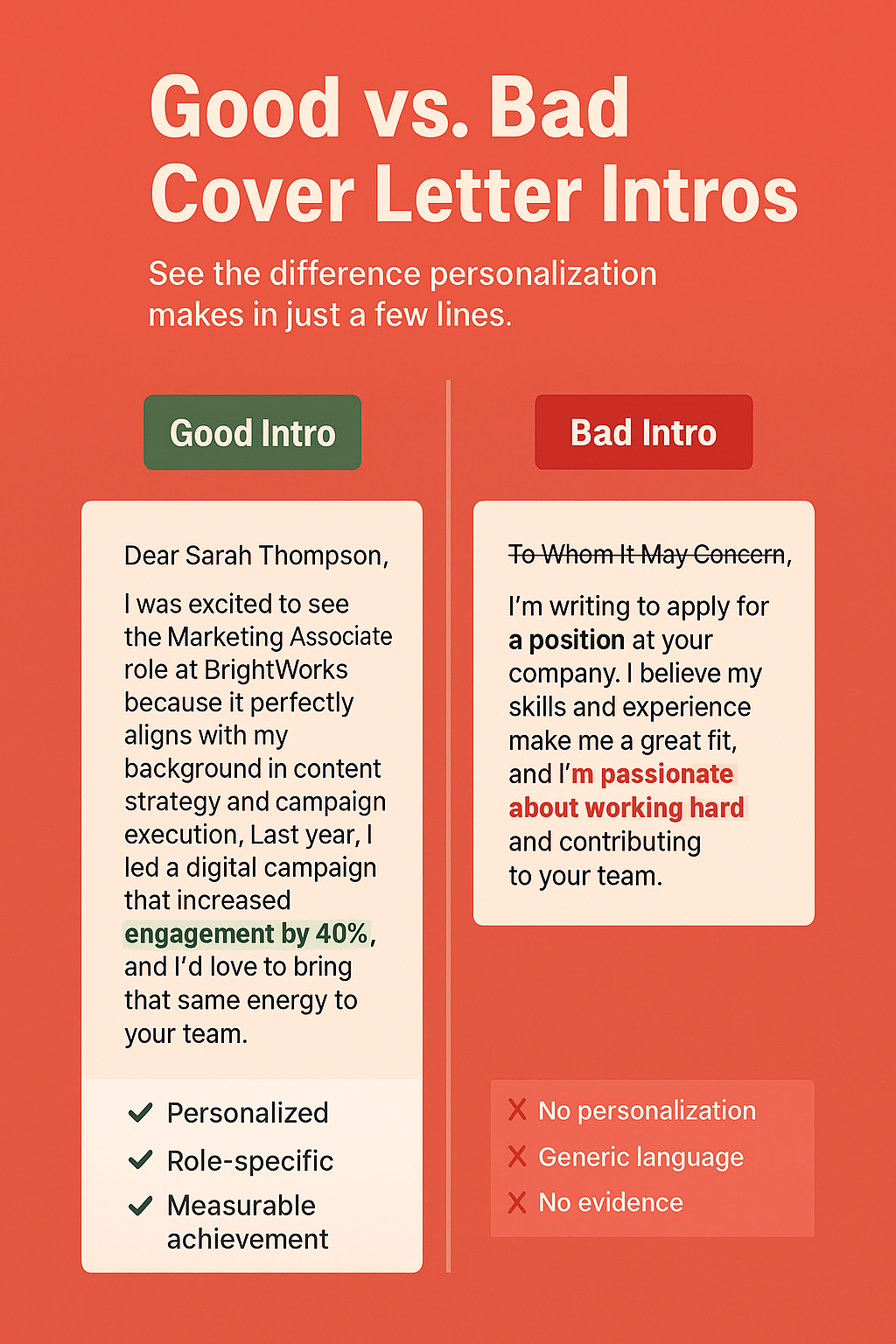
Strong Example (Breakdown)
“When I came across the Marketing Strategist role at GreenLeaf, I was immediately drawn to your mission of promoting sustainable brands. With five years of experience leading multi-channel campaigns that grew EcoMarket’s customer engagement by 45%, I’m excited by the opportunity to bring my strategic skills to a team that’s driving meaningful change.”
Why it works:
Personalized — references the specific role and company.
Motivated — explains why the mission resonates with the applicant.
Value-driven — includes a relevant achievement tied to the role.
Clear bridge between experience and company needs.
Sounds human, confident, and tailored.
This type of intro quickly builds a narrative that connects the candidate’s background with the employer’s goals — exactly what a cover letter should do.
Weak Example (Breakdown)
“To Whom It May Concern,
I am writing to apply for the Marketing Strategist position at your esteemed company. I believe my skills and experience make me a suitable candidate for this role.”
Why it fails:
Generic greeting shows no effort to personalize.
Template language like “your esteemed company” feels outdated.
No motivation — doesn’t explain why the applicant wants this job.
No proof of value — no achievements or context provided.
Could be sent to any company without changing a word.
This kind of opening doesn’t engage the reader, doesn’t build trust, and undermines your credibility from the start.
How the Purpose Differs Across Job Types
While the core purpose of a cover letter remains the same — to connect your experience and motivation to a specific role — the tone, emphasis, and storytelling style should shift depending on the job type and industry. Adapting your approach to the context shows awareness, strategic thinking, and professionalism.
Corporate Roles vs. Startups
Corporate roles often value structure, clarity, and professionalism. In these environments, cover letters should emphasize:
Clear alignment with organizational goals and job requirements
Demonstrated experience in structured, large-scale environments
A polished, formal tone that reflects the company’s culture
Example: Highlighting achievements with measurable impact, showcasing ability to work within established processes, and using a professional tone throughout.
Startups, on the other hand, typically value adaptability, initiative, and cultural alignment. For startup applications, cover letters work best when they:
Show genuine excitement for the company’s mission and growth journey
Emphasize flexibility, problem-solving, and willingness to wear multiple hats
Use a slightly more conversational and energetic tone while staying professional
Example: Sharing a brief anecdote that illustrates your ability to thrive in fast-paced, ambiguous environments.
Creative Industries vs. Technical Fields
In creative fields (e.g., marketing, design, media), cover letters should highlight:
Personal voice and storytelling, showing your unique perspective
Select examples that demonstrate originality, aesthetic judgment, or audience impact
A tone that’s polished but expressive, reflecting creativity without being casual
For technical fields (e.g., engineering, data science, IT), the focus should shift toward:
Clarity, logic, and problem-solving — showing how your skills solve real business challenges
Measurable outcomes (e.g., “increased processing speed by 30%”)
A professional, structured tone with minimal fluff, while still conveying enthusiasm for the role
This contrast isn’t about personality — it’s about aligning communication style with what the field values most.
Entry-Level vs. Senior Roles
Entry-level candidates often lack extensive work experience, so their cover letters should focus on:
Motivation, potential, and eagerness to contribute
Relevant coursework, internships, or volunteer work
Personal connection to the company’s mission or industry
Tone: Professional yet approachable — demonstrating initiative, willingness to learn, and cultural fit.
For senior roles, cover letters should convey:
Strategic impact, leadership, and high-level contributions
Clear alignment with the company’s vision and long-term goals
A confident, authoritative tone that positions the candidate as a peer to decision-makers, not just an applicant
These differences help the letter speak directly to the expectations of the role and resonate with the person reading it.
Purpose vs Other Job Application Documents
Your cover letter plays a distinct role in the job application process. While your resume, cover letter, and portfolio (or extended CV) work together, each serves a different strategic purpose. Understanding these differences will help you craft a more effective and focused application.
Document | Purpose | Tone | Main Focus |
|---|---|---|---|
Resume | Present qualifications & experience clearly | Neutral | Skills, timeline, facts |
Cover Letter | Persuade & personalize — tell your “why” | Personal, warm | Motivation, fit, story |
Portfolio / CV+ | Showcase work samples or extended details | Professional | Tangible proof of capability |
Why This Matters
Your resume shows what you’ve done.
Your cover letter explains why it matters for this specific role.
Your portfolio or extended CV proves you can deliver through real examples.
When these three components work in harmony, they reinforce each other and create a strong, memorable impression — both for human recruiters and AI screening systems.
Related
FAQ
🤔 What is the main purpose of the cover letter?
The main purpose of a cover letter is to explain why you’re applying, highlight your most relevant qualifications, and show your personality — giving important context that your resume alone can’t provide.
📝 What are the three main things needed in a cover letter?
A strong cover letter should clearly convey:
Why you want the job
Why you’re qualified for it
Why you’re a good cultural fit
This structure helps hiring managers quickly understand your motivation, value, and alignment with the company.
✍️ What is the purpose of a cover letter in a full sentence?
“The purpose of a cover letter is to persuade the employer that you’re the right candidate by connecting your skills, motivation, and fit to the role.”
What is the purpose of the letter of application?
A letter of application is another term for a cover letter. Its purpose is identical: to introduce yourself, express interest in the role, and highlight your most relevant strengths to make a compelling case for your candidacy.
What makes a good cover letter?
A good cover letter is defined by:
Clarity — It’s easy to read and focused.
Personalization — It’s tailored to the company and role.
Strong narrative — It connects your experience to their needs in a persuasive, authentic way.
Generic templates and vague language should be avoided.
What is the general purpose of a letter?
Broadly, the purpose of any letter is to communicate a message clearly and intentionally to the reader — whether that message is persuasive, informative, or personal.
Final Thoughts — Nail the “Why”
A cover letter isn’t just another box to tick — it’s your strategic pitch. It’s where you explain the “why” behind your application: why this role, why this company, and why you are the right fit.
The strongest letters are tailored, clear, and story-driven. They focus on substance, not length — a few well-crafted paragraphs that connect your experience to the company’s goals are far more powerful than a generic page of filler.
💬 Think of your cover letter as your opening argument — make it count.